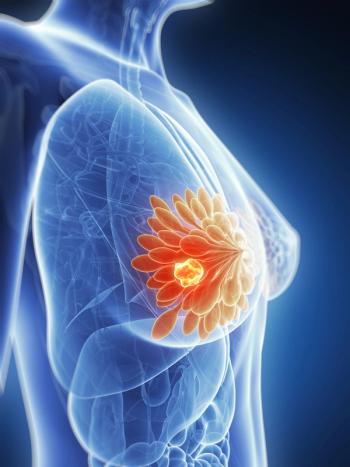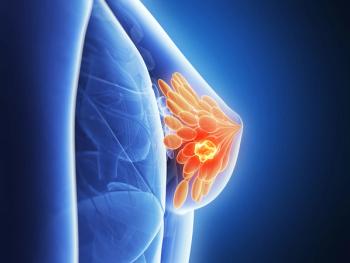
- Oncology Vol 28 No 4
- Volume 28
- Issue 4
HER2 Targeting in Early Breast Cancer: More Options and More Questions
Therapies targeting HER2 have revolutionized the treatment of breast cancer. Trastuzumab is the foundation of treatment for women with HER2-positive breast cancer. The challenge ahead is to develop predictors that can identify patients for whom trastuzumab alone will be sufficient.
The success of bench-to-bedside research focused on identifying and characterizing the ErbB2/HER family of receptors and on therapeutically targeting human epidermal growth factor receptor 2 (HER2) in the approximately 20% of patients with HER2-positive breast cancer is among the most laudable accomplishments in cancer care in the past 2 decades. The article by Brown-Glaberman and colleagues[1] is an excellent review of the advances in the treatment of early-stage HER2-positive breast cancer.
The simultaneous publication in 2005 of the first interim analysis of the combined National Surgical Adjuvant Breast and Bowel Project (NSABP) B-31/ North Central Cancer Treatment Group (NCCTG) N9831 trials[2] and the HERA trial,[3] both of which had demonstrated significant improvements in disease-free survival (DFS) and overall survival (OS) of trastuzumab added to an anthracycline-paclitaxel adjuvant regimen, was met with enthusiasm and established this regimen as an option in the management of node-positive and high-risk node-negative HER2-positive breast cancer. The final analysis of B-31/N9831, which confirmed and extended these results, was presented at the 2012 San Antonio Breast Cancer Symposium.[4] At a median follow-up of 8.4 years, adding adjuvant trastuzumab to chemotherapy resulted in significant and substantial improvement in 10-year DFS (74% vs 62%; hazard ratio [HR] = 0.60; P < .0001) and OS (84% vs 75.2%; HR = 0.63; P < .0001).
As detailed in the Brown-Glaberman et al article, adjuvant therapy of HER2-positive breast cancer can now be individualized based on risk of recurrence and comorbidities. The results of the Breast Cancer International Research Group (BCIRG) 006 trial[5] established docetaxel, carboplatin, and trastuzumab (TCH) as another highly effective adjuvant treatment with less cardiotoxicity and leukemogenesis. On the basis of these results, either TCH or doxorubicin and cyclophosphamide (AC) followed by a taxane initiated concurrently with trastuzumab constitutes standard adjuvant therapy in the United States for high-risk HER2-positive breast cancer.
Individualized treatment with less toxicity is also emerging for lower-risk T1b and T1c, node-negative, HER2-positive breast cancer. We agree that the recently reported phase II trial[6] of 12 weeks of paclitaxel plus trastuzumab followed by 9 additional months of trastuzumab-which demonstrated close to a 99% 3-year DFS-can be considered compelling and likely sufficient to justify incorporation of this regimen into the treatment strategy for these patients.
HER2-targeted neoadjuvant therapy continues to be the subject of intense clinical investigation. A fairly consistent picture is emerging in which pathologic complete response (pCR) rates are improved with dual HER2 blockade when either lapatinib or pertuzumab is added to a chemotherapy-trastuzumab backbone. The FDA’s recent accelerated approval of neoadjuvant pertuzumab added to chemotherapy-trastuzumab (utilizing a number of chemotherapy regimens, based on those that produced high pCR rates in the randomized phase II NeoSphere[7] and TRYPHAENA[8] trials) also allows for individualization of neoadjuvant therapy.
Many questions remain regarding the optimization of HER2-targeted adjuvant and neoadjuvant therapy. The role of ado-trastuzumab emtansine (T-DM1) is being investigated in both the low-risk and high-risk HER2-positive populations. As mentioned by Brown-Glaberman et al, for patients with resected stage I disease, the ATEMPT trial[9] will compare one year of this agent to the 12-week paclitaxel+trastuzumab-followed-by-trastuzumab regimen. The NSABP, the German Breast Group, and other investigators are collaborating on a global trial (KATHERINE)[10] that will evaluate T-DM1 as an alternative to continuation of trastuzumab in women with residual disease following neoadjuvant chemotherapy combined with HER2-targeted therapy.
In estrogen receptor (ER)-positive/HER2-positive tumors, the ER pathway may be an escape mechanism from HER2 targeted therapy. Preclinical and clinical findings strongly support the use of multi-agent anti-HER2 therapy along with endocrine therapy for optimal antitumor effect.[11] NSABP B-52[12] is a phase III trial evaluating the addition of estrogen deprivation to neoadjuvant docetaxel, carboplatin, trastuzumab, and pertuzumab in women whose tumors are both hormone receptor–positive and HER2-positive. The B-52 trial recently opened to accrual.
Therapies targeting HER2 have revolutionized the treatment of breast cancer. Trastuzumab is the foundation of treatment for women with HER2-positive breast cancer. Many additional exciting new agents are now available for women with HER2-positive disease. The challenge ahead is to develop predictors that can identify patients for whom trastuzumab alone will be sufficient, and to understand and overcome mechanisms of resistance, in order to provide the most effective, personalized treatment available.
Financial Disclosure:The NSABP is supported by Public Health Service grants U10-CA-37377, -69974, -12027, and -69651, from the National Cancer Institute, the National Institutes of Health, and the Department of Health and Human Services.
References:
1. Brown-Glaberman U, Dayao Z, Royce, M. HER2-targeted therapy for early-stage breast cancer: a comprehensive review. Oncology (Williston Park). 2014;28:-281-9.
2. Romond EH, Perez EA, Bryant J, et al. Trastuzumab plus adjuvant chemotherapy for operable HER2-positive breast cancer. N Engl J Med. 2005;353:1673-84.
3. Piccart-Gebhart MJ, Procter M, Leyland-Jones B, et al. Trastuzumab after adjuvant chemotherapy in HER2-positive breast cancer. N Engl J Med. 2005;353:1659-72.
4. Romond E, Suman VJ, Jeong J-H, et al. Trastuzumab plus adjuvant chemotherapy for HER2-positive breast cancer: final planned joint analysis of overall survival (OS) from NSABP B-31 and NCCTG N9831. San Antonio Breast Cancer Symposium 2012; San Antonio, TX. Abstr S5-5.
5. Slamon D, Eiermann W, Robert N, et al. Adjuvant trastuzumab in HER2-positive breast cancer. N Engl J Med. 2011;365:1273-83.
6. Tolaney SM, Barry WT, Dang CT, et al. Adjuvant paclitaxel and trastuzumab for node-negative HER2+ breast cancer. San Antonio Breast Cancer Symposium 2013; San Antonio, TX. Abstr S1-04.
7. Gianni L, Pienkowski T, Im YH, et al. Efficacy and safety of neoadjuvant pertuzumab and trastuzumab in women with locally advanced, inflammatory, or early HER2-positive breast cancer (NeoSphere): a randomised multicentre, open-label, phase 2 trial. Lancet Oncol. 2012;13:25-32.
8. Schneeweiss A, Chia S, Hickish T, et al. Pertuzumab plus trastuzumab in combination with standard neoadjuvant anthracycline-containing and anthracycline-free chemotherapy regimens in patients with HER2-positive early breast cancer: a randomized phase II cardiac safety study (TRYPHAENA). Ann Oncol. 2013;24:2278-84.
9. T-DM1 vs paclitaxel/trastuzumab for breast (ATEMPT Trial). ClinicalTrials.gov Identifier: NCT01853748. Available from:
10. A study of trastuzumab emtansine versus trastuzumab as adjuvant therapy in patients with HER2-positive breast cancer who have residual tumor in the breast or axillary lymph nodes following preoperative therapy (KATHERINE). ClinicalTrials.gov Identifier: NCT01772472. Available from:
11. Wang YC, Morrison G, Gillihan R, et al. Different mechanisms for resistance to trastuzumab versus lapatinib in HER2-positive breast cancers-role of estrogen receptor and HER2 reactivation. Breast Cancer Res. 2011;13:R121.
12. NSABP B-52: Docetaxel, carboplatin, trastuzumab, and pertuzumab with or without estrogen deprivation in treating patients with hormone receptor-positive, HER2-positive operable or locally advanced breast cancer. ClinicalTrials.gov Identifier: NCT02003209. Available from:
Articles in this issue
over 11 years ago
HER2-Positive Breast Cancer: The Story Goes Onover 11 years ago
Diffuse Large B-Cell Lymphoma: One Treatment No Longer Fits Allover 11 years ago
Diffuse Large B-Cell Lymphoma: Changing Treatment Paradigmsover 11 years ago
Large Renal Mass: A Challenge for the UrologistNewsletter
Stay up to date on recent advances in the multidisciplinary approach to cancer.

















































































